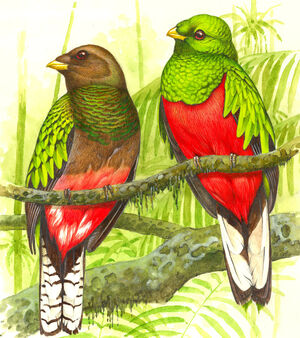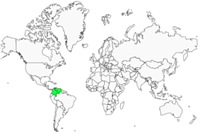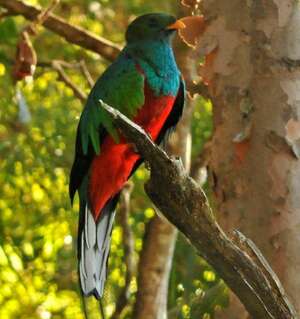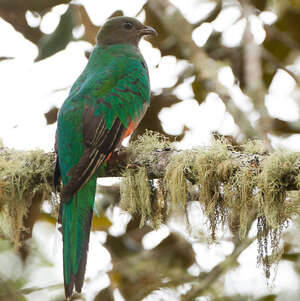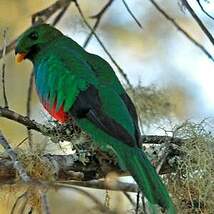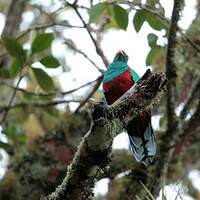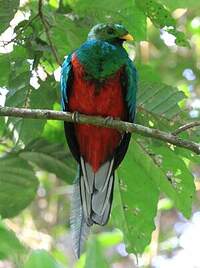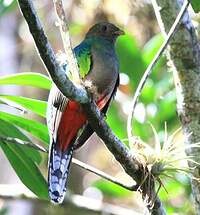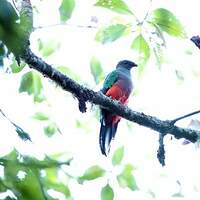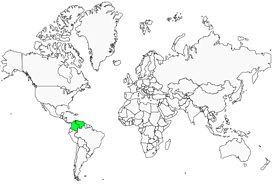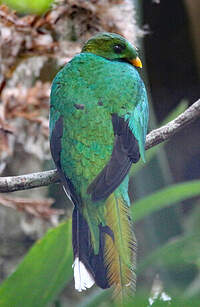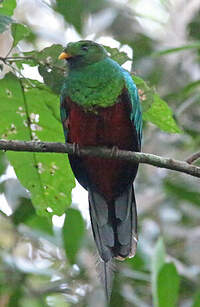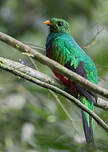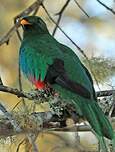White-tipped Quetzal
Pharomachrus fulgidus - Quetzal brillant
Identification
Pharomachrus fulgidus is a combination of Greek pharomachrus, meaning 'the bird with the long mantle', and Latin fulgidus, which can be translated as 'bright, lustrous', with fulgurant likely having the same origin. John Gould called it Trogon fulgidus in 1838, and we have named it White-tipped Quetzal, while our more pragmatic Anglo-Saxon friends named it White-tipped Trogon or Trogon with White Tips. Our White-tipped Quetzal certainly forms a superspecies with the Pavonine Quetzal, the Golden Quetzal or the Antillean Quetzal, and the Resplendent Quetzal, measuring about 33 cm and showing a pronounced dimorphism. The male has a yellow beak, a golden head and neck, and depending on the light, almost looks to have a golden helmet. Its iris is brown, its parotidi are dark green, brightening to an emerald green on the throat and chest, the belly is carmine red, the mantle and back take on the emerald green of the chest, and the upper tail-feathers will often display golden reflections depending on the light. As with all Quetzals, the coverts are worn vertically in the same green color as the mantle, all primaries are black with white margins, and curve over the rump. The three pairs of lower rectrices are black, although only the pair at the base of the tail displays this coloring, the tips are very widely marked with white, and when the bird is seen from the front, the tail appears white. The female is more discreet, its head is brown with golden and green highlights on the cap and neck, its iris is dark brown, its beak yellow, with a gray culmen.The brown throat is marked by horizontal green waves on the chest, but depending on the light some individuals appear completely brown on the chest and the upper part of the belly, the lower belly is a faded red almost pink with the base of the feathers white. The mantle and back are green, the coverts green, shorter than those of the male, showing the black remiges. The lower black rectrices are marked with white spots, the tail thus has a rather striped appearance. The young resemble their mother, but young males will soon have the lower rectrices white. Two ssp are recognized, ssp fulgidus described above and ssp festatus with longer undertail coverts and a more golden hue, the rectrices are also longer, this ssp will more easily show the green tips at the end of the tail.
Subspecific information 2 subspecies
- Pharomachrus fulgidus fulgidus (n Venezuela)
- Pharomachrus fulgidus festatus (n Colombia)
Foreign names
- Quetzal brillant,
- Quetzal fúlgido,
- quetzal-de-pontas-brancas,
- Glanztrogon,
- Santa-Martaquetzal,
- Quetzal codabianca,
- glansquetzal,
- Bronsekroneketsal,
- kvesal bielochvostý,
- kvesal lesklý,
- Hvidspidset Quetzal,
- kahviketsaali,
- quetzal fulgent,
- kwezal białosterny,
- Алмазный квезаль,
- オジロカザリキヌバネドリ,
- 白尾梢绿咬鹃,
- 白尾梢綠咬鵑,
Voice song and cries
Habitat
Dietfeeding habits
Reproduction nesting
In the Sierra Nevada de Santa Marta in Colombia, the White-tipped Quetzal is in its breeding season from January to April, with nesting occurring between March and August. The nests are often old nests of picidae such as the Malherbe's Woodpecker (or Crimson-crested Woodpecker) or excavations in dead tree trunks at a height of 5 to 10 m, very little information is available about the reproduction of this quetzal which will likely be similar to that of other Quetzals such as the Pavonin Quetzal.
Geographic range
Threats - protection
IUCN conservation status
concern
in the Wild
threatened
evaluated
LC, the White-tipped Quetzal does not seem to be in danger, its distribution range is extremely small and it's concentrated in parks and reserves even though it enjoys coffee plantations!
Sources of information
- IOC World Bird List (v14.1), Gill, F and D Donsker (Eds). 2024-04-18.
- A Natural history of the Trogonidae, Joseph M.Forshaw Albert Earl Gilbert
- Vol. 6 - Handbook of the Birds of the World, Josep del Hoyo-Andrew Elliott-Jordi Sargatal
- xeno-canto, Sharing bird sounds from around the world,
- ARKive, Christopher Parsons
- Avibase, Lepage Denis
- BirdLife International, BirdLife International
- HBW Alive,
- Neotropical Birds Online,
- Planet of Birds,
- The internet Bird Collection,
- Wikipédia, Wikipedia, The Free Encyclopedia
Other sources of interest
 Specification sheet created on
01/08/2023 by Anne et Gabriel Leboff
Specification sheet created on
01/08/2023 by Anne et Gabriel LeboffTranslation by AI Oiseaux.net
published: 06-10-2013 - Updated: 08-03-2024
© 1996-2024 Oiseaux.net
- Accipitriformes
- Aegotheliformes
- Anseriformes
- Apodiformes
- Apterygiformes
- Bucerotiformes
- Caprimulgiformes
- Cariamiformes
- Casuariiformes
- Charadriiformes
- Ciconiiformes
- Coliiformes
- Columbiformes
- Coraciiformes
- Cuculiformes
- Eurypygiformes
- Falconiformes
- Galliformes
- Gaviiformes
- Gruiformes
- Leptosomiformes
- Mesitornithiformes
- Musophagiformes
- Nyctibiiformes
- Opisthocomiformes
- Otidiformes
- Passeriformes
- Pelecaniformes
- Phaethontiformes
- Phoenicopteriformes
- Piciformes
- Podargiformes
- Podicipediformes
- Procellariiformes
- Psittaciformes
- Pterocliformes
- Rheiformes
- Sphenisciformes
- Steatornithiformes
- Strigiformes
- Struthioniformes
- Suliformes
- Tinamiformes
- Trogoniformes

